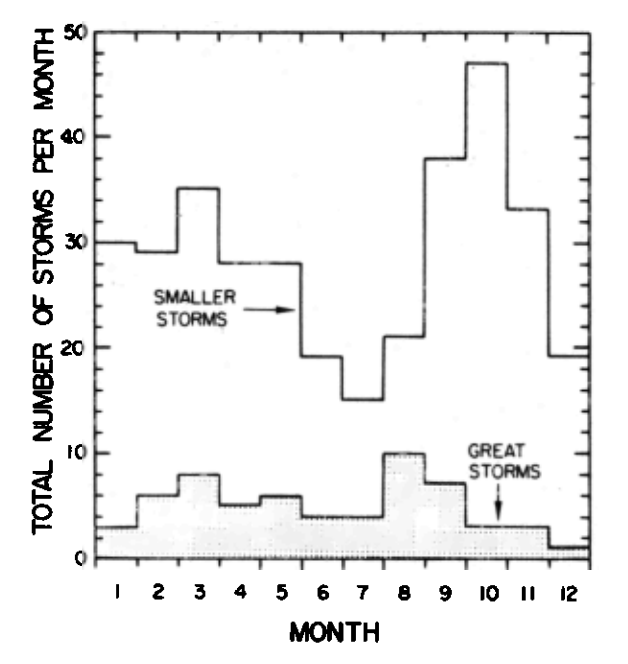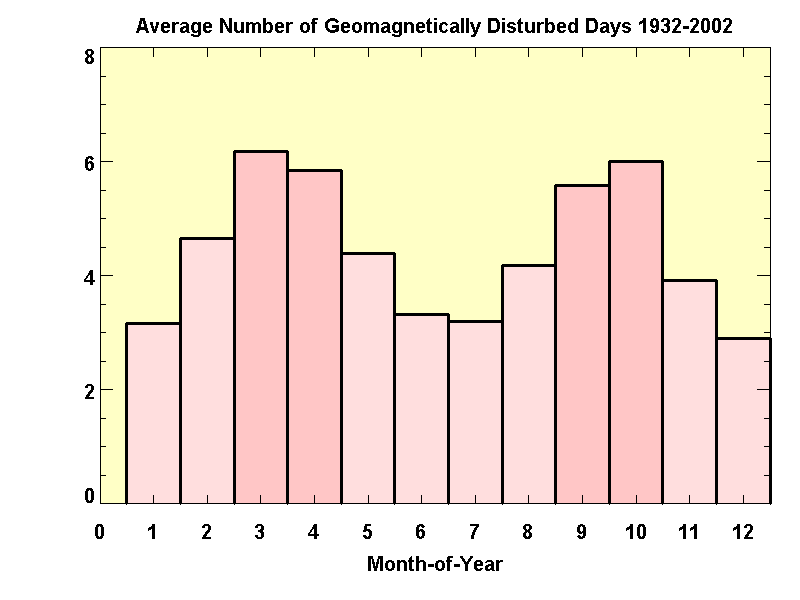
When is aurora season?
What’s the basis for the legendary connection between auroras and equinoxes? Yes, there is an aurora season, which comes in March and October (more or less around the equinoxes) each year. This pattern in nature – auroras increasing twice a year – is one of the earliest patterns ever to be observed and recorded by scientists.
We know that storms and eruptions on the sun cause disturbances in Earth’s magnetic field, called geomagnetic storms. And we know the sun itself has cycles, including the famous 11-year solar cycle. That cycle is in an upswing now, by the way, which is why we’re having more solar activity now than a few years ago. But an 11-year cycle is not a twice-yearly cycle. Why would geomagnetic storms increase twice a year?
As it turns out, it’s all about magnetism and geometry.
Aurora season: Early studies
And it’s something nature-watchers have studied for a long time. Aloysius Cortie, an English Jesuit astronomer who conducted sun studies around the turn of the last century, published first notable journal paper on the link between equinoxes and auroras in the year 1912.
Then in 1940, the mathematician Sydney Chapman and his German colleague Julius Bartels included another discussion of the twice-yearly aurora season in their classic book Geomagnetism. This 1940 book became the standard text book on Earth’s magnetism for several decades. And it illustrated the seasonal variation in geomagnetic storms in the plot below:

Later, a solar physicist – David Hathaway of NASA’s Marshall Space Flight Center – created an updated plot showing the same seasonal pattern. Hathaway’s plot is below:

The Russell-McPherson effect
Over the years, scientist put forth several models to explain the twice-a-year variation in geomagnetic storm. An enduring explanation comes from Christopher Russell and Robert McPherron, both of UCLA. Their 1973 paper on the subject was titled Semiannual Variation of Geomagnetic Activity.
Although their model explaining the seasonal variation in aurora frequency didn’t explain everything perfectly, it did show a physical connection between the geometry of Earth’s magnetic field and the magnetic field carried to Earth from the sun by the solar wind. And thats why, since the 1973 paper, the term Russell-McPherson effect has been used for the seasonal aurora.
So what’s the connection?
The Bz component. You know how a magnet always comes with two poles: a north pole and a south pole? Solar magnetic fields – carried to Earth via the solar wind – also have a north and south pole. Russell and McPherron showed that the “north-south” component of the sun’s magnetic field – called the Bz component by solar physicists – goes up and down over the year, in a way corresponding to the wobbling of Earth’s axis. They showed these fluctuations are largest during the equinoxes. Geomagnetic storms – and therefore auroras – happen most often when the “north-south” component of the solar wind is more or less opposite the “north-south” component of Earth’s own magnetic field.
It happens because – just as when two bar magnets oriented oppositely attract one another – so opposite Bz components attract. They open up a hole in Earth’s magnetic field, which allows the solar wind to flow more easily toward Earth’s magnetic poles.
When this happens, presto, we have auroras!

The equinoctial effect
There is another factor that comes into place that also increases aurora during equinoxes. It’s called the equinoctial effect. Equinoctial just means happening at or near the time of an equinox.
Many of the competing models to that of Russel and McPherson are based on the equinoctial effect. It’s not as strong as the effect mentioned above, but it does add to the equinox-aurora connection.
Here’s how it works. During equinoxes, Earth’s magnetic poles (north and south) are at right angles to the flowing solar wind, two times a day. During these times, the solar wind is effectively stronger, enhancing magnetic storms. As the seasons change, the poles either point more toward or away from the sun reducing this effect.
See what we mean? Magnetism … and the geometry of worlds in space.

Magnetism and geometry in aurora season
So there is a reason why auroras are more frequent around the equinoxes. Researchers have been studying the phenomenon for over 100 years and still are studying it. They might not agree on all the details, but they do agree that the cause relates to the magnetic fields of both the sun and the Earth, working in conjunction with the sun-Earth geometry at a given time of year, as Earth moves in its orbit.
As meteorologist Curtis Grevenitz wrote this in his WeatherWise article for KTVH-News in Helena, Montana:
It is not just a coincidence that these two beautiful phenomena have a relationship.
To our readers and community
We invite all of our readers to send us your recent photos of auroras. We love receiving your photos. View our community photo page, or submit your image here.
Bottom line: An aurora season occurs in March and October each year, due to the way the magnetic fields of the sun and the Earth work in conjunction with sun-Earth geometry at a given time of year.
The post Aurora season: Why more auroras at equinoxes? first appeared on EarthSky.
0 Commentaires